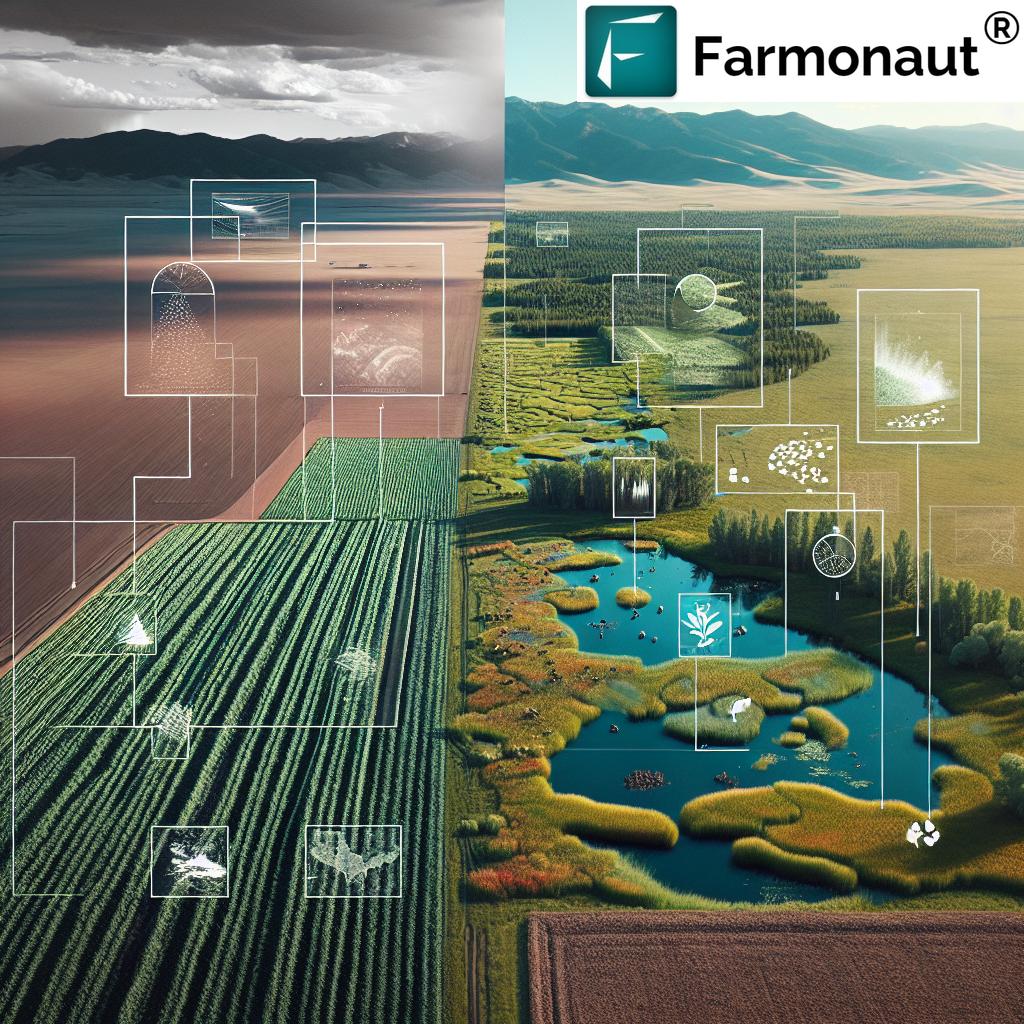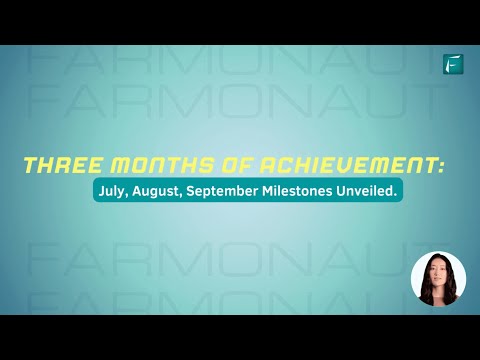Unlocking Montana’s Agricultural Future: How Farmonaut Supports USDA Conservation Easement Programs
“Montana’s ACEP program has protected over 100,000 acres of agricultural land and wetlands since its inception.”
Welcome to our comprehensive guide on how agricultural conservation easements and wetland reserve programs are shaping sustainable agriculture practices across Montana. In this blog post, we’ll explore the USDA Natural Resources Conservation Service’s latest initiatives, including the Agricultural Conservation Easement Program (ACEP), and how Farmonaut’s innovative technology is supporting these crucial efforts.
Understanding USDA Conservation Easement Programs
The United States Department of Agriculture (USDA) has long been at the forefront of promoting sustainable agriculture and preserving our nation’s natural resources. In Montana, these efforts have taken on particular significance, given the state’s vast agricultural lands and diverse ecosystems. Let’s delve into the key programs that are making a difference:
Agricultural Conservation Easement Program (ACEP)
The ACEP is a cornerstone of the USDA’s conservation efforts, designed to protect working agricultural lands and restore wetlands. This program offers two distinct options:
- Agricultural Land Easements (ALE): These easements help landowners and land trusts protect working agricultural lands and limit non-agricultural uses of the land.
- Wetland Reserve Easements (WRE): These easements offer landowners the opportunity to protect, restore, and enhance wetlands on their property.
Both options play a crucial role in preserving Montana’s agricultural heritage and ecological diversity. Let’s take a closer look at each:
Agricultural Land Easements (ALE)
ALEs are a powerful tool for preserving farmland and ranchland across Montana. Here’s how they work:
- Landowners voluntarily limit future development on their property while retaining ownership and agricultural use.
- The USDA provides financial assistance to eligible partners (such as state or local governments and non-governmental organizations) to purchase these easements.
- The program helps keep working lands in agriculture and prevents conversion to non-agricultural uses.
By participating in the ALE program, Montana’s farmers and ranchers can ensure that their land remains dedicated to agricultural production for generations to come.
Wetland Reserve Easements (WRE)
Wetlands are vital ecosystems that provide numerous benefits, including wildlife habitat, water quality improvement, and flood mitigation. The WRE program focuses on:
- Restoring, protecting, and enhancing wetlands on private and tribal lands.
- Offering landowners the option to establish conservation easements in perpetuity or for 30 years.
- Providing technical and financial assistance to landowners for wetland restoration activities.
Through the WRE program, Montana’s landowners can play a crucial role in preserving these essential ecosystems while potentially benefiting from financial incentives.

How Farmonaut Supports Conservation Efforts
At Farmonaut, we’re committed to supporting sustainable agriculture practices through our advanced technology solutions. Our satellite-based farm management platform offers valuable tools that complement USDA conservation programs:
- Satellite-Based Crop Health Monitoring: Our technology helps farmers monitor vegetation health (NDVI) and soil moisture levels, enabling more efficient resource management and supporting conservation goals.
- Jeevn AI Advisory System: This AI-driven tool provides real-time insights and expert crop management strategies, helping farmers implement sustainable practices aligned with conservation easement requirements.
- Carbon Footprinting: Our platform allows agribusinesses to track their carbon footprint, supporting efforts to reduce environmental impact and comply with conservation standards.
By leveraging Farmonaut’s technology, Montana’s farmers and landowners can more effectively implement and manage conservation easements, ensuring the long-term sustainability of their agricultural operations.
Explore Farmonaut’s solutions:
Benefits of USDA Conservation Easement Programs
Participating in USDA conservation easement programs offers numerous benefits for Montana’s landowners and the broader community:
- Preservation of Agricultural Heritage: By limiting non-agricultural land use, these programs help maintain Montana’s rich farming and ranching traditions.
- Wildlife Habitat Protection: Conservation easements create safe havens for diverse wildlife species, supporting biodiversity across the state.
- Soil and Water Conservation: Implementing sustainable practices helps preserve soil health and protect water resources for future generations.
- Financial Incentives: Landowners can benefit from various funding opportunities and potential tax benefits associated with conservation easements.
- Climate Change Mitigation: By preserving grasslands and wetlands, these programs contribute to carbon sequestration efforts.
“The USDA’s Wetland Reserve Easements have restored more than 2.7 million acres of wetlands nationwide as of 2021.”
Eligibility and Application Process
Understanding the eligibility criteria and application process is crucial for Montana landowners interested in participating in USDA conservation easement programs. Here’s an overview:
Eligibility Criteria
- Agricultural Land Easements (ALE):
- Land must be cropland, rangeland, grassland, pastureland, or nonindustrial private forest land.
- Landowners must comply with USDA’s Highly Erodible Land and Wetland Conservation provisions.
- Properties must have an approved conservation plan for highly erodible lands.
- Wetland Reserve Easements (WRE):
- Eligible lands include farmed wetlands, prior converted cropland, rangeland, pastureland, and forest land.
- The land must be restorable and suitable for wildlife benefits.
- Landowners must have owned the land for at least 24 months prior to application.
Application Process
- Contact your local NRCS office: Begin by reaching out to the Natural Resources Conservation Service office in your area.
- Submit application: Complete and submit the necessary application forms provided by the NRCS.
- Agency review: The NRCS will review your application and assess the property’s eligibility.
- Ranking and selection: Applications are ranked based on conservation benefits and selected for funding accordingly.
- Agreement and implementation: If selected, you’ll work with the NRCS to develop and implement a conservation plan.
Remember, Farmonaut’s technology can assist you throughout this process by providing valuable data and insights to support your conservation efforts.

USDA Conservation Easement Programs Comparison
| Program Aspect | Agricultural Land Easements (ALE) | Wetland Reserve Easements (WRE) |
|---|---|---|
| Primary Focus | Protect working agricultural lands | Restore and enhance wetlands |
| Eligibility Criteria | Cropland, rangeland, grassland, pastureland, or nonindustrial private forest land | Farmed wetlands, prior converted cropland, rangeland, pastureland, and forest land |
| Funding Available (Estimated) | Up to 50% of fair market value for permanent easements | Up to 100% of restoration costs and easement value for permanent easements |
| Land Use Restrictions | Limits non-agricultural uses while allowing continued farming/ranching | Restricts most uses to focus on wetland restoration and wildlife habitat |
| Conservation Benefits | Preserves agricultural heritage, protects open spaces, supports local food systems | Enhances wildlife habitat, improves water quality, mitigates flooding |
| Application Process | Apply through eligible partners (e.g., land trusts, state/local governments) | Apply directly to NRCS |
Farmonaut’s Role in Supporting Conservation Efforts
As we continue to support Montana’s agricultural community in their conservation efforts, Farmonaut’s technology plays a crucial role in enhancing the effectiveness of USDA conservation easement programs. Here’s how our platform contributes:
- Precision Agriculture for Conservation: Our satellite-based monitoring helps farmers implement conservation practices with greater accuracy, ensuring compliance with easement requirements while optimizing agricultural production.
- Data-Driven Decision Making: By providing real-time insights on crop health and soil conditions, we enable landowners to make informed decisions that align with their conservation goals.
- Efficient Resource Management: Our tools for monitoring water usage and soil moisture help farmers conserve resources, supporting the overall objectives of conservation easements.
- Documentation and Reporting: Farmonaut’s platform can assist in documenting conservation efforts and generating reports, which may be valuable for program compliance and monitoring.
To learn more about how Farmonaut can support your conservation efforts, visit our API Developer Docs or explore our API services.
Success Stories: Conservation in Action
While we can’t provide specific case studies, it’s worth noting that many Montana farmers and ranchers have successfully implemented conservation easements with positive outcomes. These success stories often include:
- Preservation of multi-generational family farms
- Restoration of critical wetland habitats
- Improved soil health and water quality on agricultural lands
- Enhanced wildlife corridors and biodiversity
These achievements demonstrate the tangible benefits of USDA conservation programs and the potential for positive impact when combined with advanced agricultural technologies like those offered by Farmonaut.
The Future of Conservation in Montana Agriculture
As we look to the future, the role of conservation easements in Montana’s agricultural landscape is set to grow even more significant. Here are some trends and developments to watch:
- Increased Focus on Climate Resilience: Conservation programs are likely to place greater emphasis on practices that enhance climate resilience and carbon sequestration.
- Integration of Technology: Advanced tools like Farmonaut’s platform will become increasingly integral to implementing and monitoring conservation efforts.
- Expansion of Urban-Rural Partnerships: We may see more collaborations between urban communities and rural landowners to preserve agricultural lands near growing cities.
- Enhanced Funding Opportunities: As the importance of conservation grows, there may be increased public and private funding available for easement programs.
By staying informed about these developments and leveraging the right tools and resources, Montana’s agricultural community can continue to lead the way in sustainable land management and conservation.
Frequently Asked Questions
Q: How long do conservation easements last?
A: Conservation easements can be permanent or for a fixed term, typically 30 years. Permanent easements offer the greatest level of protection and often come with more significant financial incentives.
Q: Can I still farm or ranch on land under a conservation easement?
A: Yes, agricultural land easements are designed to keep working lands in production while limiting non-agricultural uses. The specific allowed uses will be outlined in your easement agreement.
Q: How does Farmonaut’s technology integrate with conservation easement programs?
A: Farmonaut’s satellite-based monitoring and AI-driven insights can help landowners implement and manage conservation practices more effectively, ensuring compliance with easement requirements while optimizing agricultural production.
Q: Are there tax benefits associated with conservation easements?
A: Yes, donating a conservation easement may qualify you for federal income tax deductions and potential state tax credits. However, it’s essential to consult with a tax professional for specific advice.
Q: How competitive is the application process for USDA conservation easement programs?
A: The process can be competitive, as funding is limited. Applications are ranked based on their potential conservation benefits, so working with local NRCS offices and using tools like Farmonaut to demonstrate your commitment to conservation can strengthen your application.
Conclusion
USDA conservation easement programs offer Montana’s landowners a powerful opportunity to preserve their agricultural heritage, protect vital ecosystems, and contribute to sustainable land management practices. By combining these programs with innovative technologies like those offered by Farmonaut, we can create a more resilient and sustainable agricultural future for Montana.
We encourage all interested landowners to explore these programs further and consider how they might benefit both their operations and the broader community. Remember, conservation is not just about preserving the past; it’s about securing a thriving future for Montana’s agricultural lands and the people who steward them.
To learn more about how Farmonaut can support your conservation efforts and agricultural practices, explore our platform today:
Additional Resources
- USDA NRCS Agricultural Conservation Easement Program
- NRCS Montana State Office
- Farmland Information Center – Montana






